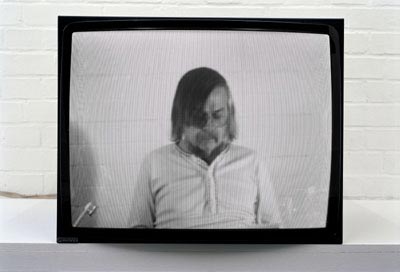 John Baldessari: Baldessari Sings LeWitt, 1972 video on DVD, 13 min. courtesy Electronic Arts Intermix, New York © Jürgen Schulz Funky Lessons John Baldessari, Monica Bonvicini, Andrea Fraser, Martin Gostner, Eva Grubinger, Erik van Lieshout, Marko Lulic, Aleksandra Mir, Adrian Piper, Tino Sehgal, Annika Ström, Barbara Visser, Franz West Click for English text Unter dem Titel "Funky Lessons" präsentiert die BAWAG FOUNDATION Arbeiten von 13 KünstlerInnen aus 6 Ländern. Um einen Kern klassischer Arbeiten (Adrian Piper, John Baldessari) gruppieren sich jüngere (Andrea Fraser, Eva Grubinger, Erik van Lieshout, Franz West) und exklusiv für die Ausstellung realisierte Arbeiten (Monica Bonvicini, Martin Gostner, Marko Lulic, Aleksandra Mir, Tino Sehgal, Annika Ström, Barbara Visser). Ein gängiger Vorwurf besonders gegen konzeptuelle Kunst lautet, sie sei zu didaktisch. Die Ausstellung versammelt Arbeiten, die das Problem der Didaktik direkt angehen: Sie brechen Autorität und biegen erhobene Zeigefinger, verzichten aber dennoch nicht auf Wissen und Kritik. Humor ist die Waffe der Entwaffnung in Performance, Video, Installation, Text-Arbeiten und Skulptur. Es eröffnen sich Wege aus einer Sackgasse der Kunst: jenseits der falschen Wahl zwischen harmloser Hermetik und belehrender Bevormundung. Titelgebend für die Ausstellung ist das Video "Funk Lessons" (1983) von Adrian Piper: die Künstlerin gibt darin - meist weissen - Studenten Tanzunterricht in Disco-Funk, mit teils Slapstick-artigem Ergebnis. Ein anderes klassisches Beispiel wäre John Baldessaris "Baldessari Sings LeWitt" von 1972: Baldessari singt wie ein Laienprediger die berühmten, trocken ernsten Sätze zur Konzeptuellen Kunst von Sol LeWitt zur Melodie bekannter Songs, u.a. der US-Hymne. Oder Franz Wests Kreuzung aus Sockel und Rednerpult "Laokoon's federnder Kopf (Lessingstudie)" von 2002, in deren Ablage ein Reklam-Heftchen mit Lessings Schrift "Laokoon oder über die Grenzen von Malerei und Poesie" liegt. Darin spielt Lessing das Skulpturale, das statisch sei, gegen die Poesie, die beweglich sei, aus. West widerlegt dies mit der unförmigen, rötlich verklumpten Plastik, die mit einer Stahlfeder freischwingend auf dem Pult befestigt ist. Zur Ausstellung erscheint in Zusammenarbeit mit dem Revolver Verlag ein ca. hundertseitiger, zweisprachig deutsch-englischer Katalog. Dieser enthält Interviews, die Kurator Jörg Heiser mit allen beteiligten Künstlern zu den Werken in der Ausstellung und deren Thema geführt hat. Hinzu kommen Gespräche mit Thomas Bayrle, langjähriger Professor an der Städelschule Frankfurt/Main, über das Problem des Lehrens von Kunst, sowie mit den Popkritikern Kerstin Grether und Klaus Walter zu den "Funky Lessons" der Musik. Ergänzt werden die Interviews durch kurze Einführungstexte zum jeweiligen Oeuvre und Abbildungen aller gezeigten Arbeiten. Kurator Jörg Heiser Ausstellungsdauer: 17.12.2004 - 26.2.2005 Oeffnungszeiten: Mo-Sa 10 - 18 Uhr Führungen jeweils Sa 15 Uhr Bawag Foundation Tuchlauben 7a A-1010 Wien Telefon +43 1 534 53-222 96 Fax +43 1 534 53-230 96 Email foundation@bawag.com www.bawag-foundation.at Funky Lessons John Baldessari, Monica Bonvicini, Andrea Fraser, Martin Gostner, Eva Grubinger, Erik van Lieshout, Marko Lulic, Aleksandra Mir, Adrian Piper, Tino Sehgal, Annika Ström, Barbara Visser, Franz West The exhibition "Funky Lessons" in the BAWAG FOUNDATION comprises works by 13 artists from 6 countries. After its presentation in the Berlin BüroFriedrich, it will now be on show in Vienna. Quite recent works (Andrea Fraser, Eva Grubinger, Erik van Lieshout, Franz West) and works created specifically for the exhibition (Monica Bonvicini, Martin Gostner, Marko Lulic, Aleksandra Mir, Tino Sehgal, Annika Ström, Barbara Visser) will be grouped around a core of classical pieces (Adrian Piper, John Baldessari). A common resentment against conceptual art is that it was too didactic. The exhibition brings together works by artists that tackle the problem head-on: they undermine the authority of educational forms, yet do not simply renounce knowledge and critique. Humor and role play are the disarming weapons used in performance, video, installation, painting, and sculpture. New ways open up beyond the cul-de-sac of a false choice between harmless hermeticism and patronizing gestures. The title of the exhibition is inspired by Adrian Piper's pivotal piece "Funk Lessons" (1982-1984), a video based on a performance by the artist teaching - a mostly white - audience of students basic and advanced dance routines of funk and soul music. Another classic example is John Baldessari's "Baldessari Sings Lewitt" of 1972: the artist sings, like a lay preacher, the famous stern "Sentences on Conceptual Art" by Sol Lewitt to the melody of famous songs, among them the US anthem. Or Franz West's cross between a pedestal and a lectern "Laocoon's springy head (Lessing study)" of 2002, with a paperback copy of Lessing's "Laocoon; or On the Limits of Painting and Poetry" casually placed inside of it. In the book, Lessing plays off sculpture, which according to him was static, against poetry, which was in motion. West counters the assumption with an amorphous, reddish lump mounted with a rusty steel spring onto the top of the lectern. A catalogue of about 100 pages in German and English will be published on the occasion of the exhibition in collaboration with Revolver Verlag. The catalogue will comprise interviews conducted by Jörg Heiser, the curator, with all participating artists on the works presented in the exhibition and their subjects. The publication will also feature interviews with Thomas Bayrle, who has held a professorship at the Städelschule in Frankfurt/Main for a long time, on the issue of teaching art and the pop critics Kerstin Grether and Klaus Walter on the "funky lessons" of music. Short introductions on the various artists' oeuvres and reproductions of all works shown will round off the publication. Curator: Jörg Heiser December 17, 2004 - February 26, 2005 |